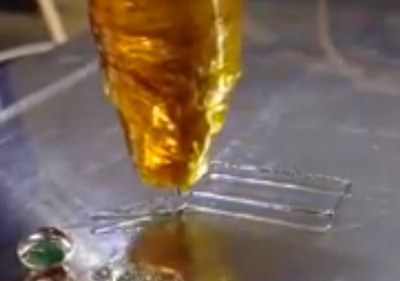RepRap Blogger Jordan Miller reports on an experiment building a unique 3D printer capable of producing sweet sugar glass to aid his bioengineering research. The key problem revolved around being able to use Miller’s BariCUDA extruder, an air pressure-powered extruder. The BariCUDA weighs several pounds and would be difficult to move quickly or accurately with conventional 3D printing extruder movement mechanisms.
The solution came through a suggestion to mount the BariCUDA on a ShopBot Desktop, which is normally a CNC router, capable of cutting or contouring wood, foam, metal or plastic. In other words, it’s a rough and tough platform that could easily hold the BariCUDA.
Miller and team (including expertise from ShopBot itself) not only had to physically mount the extruder on the ShopBot in place of its usual cutting tool, but also had to replace all the electronics with an Ultimachine board capable of driving the hybrid machine for 3D printing.
The result, of course, was a success. The ShopBot was able to not only hold the heavy extruder, but also rapidly move it – something it does routinely when chopping up hardwood.
The lesson here is that for all the experiments 3D printer inventors have done to this point, it may be time to more deeply examine the work done by CNC makers to see how they’ve overcome mechanical constraints to build highly successful machines. Speed, accuracy, reliability and robustness are characteristics all machines could use more of.


